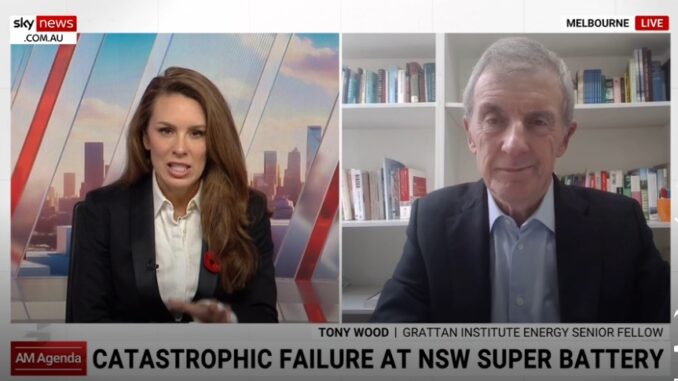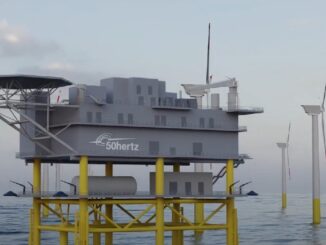
In a stark reminder of the challenges facing Australia’s ambitious shift from coal to renewable energy, the Waratah Super Battery project—one of the world’s largest battery storage systems—has suffered a “catastrophic” transformer failure, delaying its full completion by at least six months and potentially more.
This $1 billion initiative, designed to act as a “shock absorber” for the grid by storing excess renewable energy from wind and solar sources, has been plagued by setbacks including bad weather and now this major equipment malfunction, reducing its operational capacity and raising questions about the reliability of such mega-projects.
Experts warn that this failure not only underscores the technical and financial risks inherent in the renewables push but also threatens to unravel the timeline for phasing out cheap, reliable coal power, leaving the nation’s energy security hanging in the balance.
The Waratah Super Battery, located in New South Wales, was heralded as a cornerstone of Australia’s renewable energy future. With a capacity to power hundreds of thousands of homes during peak demand, it was meant to smooth the intermittency of wind and solar generation, allowing for a smoother transition away from coal-fired plants.
However, the recent transformer failure has forced the project into partial operations, with completion now pushed back significantly. This comes on top of earlier delays, highlighting a pattern of unforeseen issues that could cascade into broader grid instability. As one energy analyst noted, “Storage technology has made projects like Waratah feasible, but failures like this expose the vulnerabilities in scaling up too quickly.”
Australia’s Broader Coal-to-Renewables Transition: Ambitious Plans Meet Harsh Realities
Australia’s federal and state governments have long touted a rapid pivot to renewables, aiming for net-zero emissions by 2050 through massive investments in wind, solar, hydro, and battery storage.
The plan involves phasing out coal-fired power, which currently supplies a significant portion of the nation’s electricity, in favor of intermittent sources backed by storage. Queensland, a coal-dependent state, initially committed to shutting down coal units by 2035 to achieve an 80% renewable energy target, emphasizing wind and solar expansion.
Nationally, the Australian Energy Market Operator (AEMO) has outlined a pathway where coal is entirely replaced by clean power, describing the shift as “not only possible but inevitable.”
Yet, recent policy reversals paint a different picture. In October 2025, Queensland backtracked on its 2035 coal closure deadline, citing the need for energy reliability amid delays in renewable rollout.
This move reflects growing concerns that eliminating cheap coal too hastily could lead to blackouts and higher prices, especially as gas fills the gaps left by unreliable renewables.
Proponents argue that renewables have already saved billions by curbing power costs, but critics point to the intermittency issues that batteries like Waratah were supposed to solve.
Delays and Escalating Costs: The Hidden Toll of the Transition
The Waratah failure is symptomatic of wider problems in Australia’s renewable sector, where delays and cost overruns are becoming the norm rather than the exception. Investment in large-scale solar and wind projects plummeted 64% in 2025, with no new wind farms reaching financial close in the first half of the year.
Key transmission infrastructure, such as the VNI West and Marinus Link projects, has faced repeated setbacks and ballooning budgets, exacerbating grid bottlenecks that force solar farms to curtail up to 65% of their output in southeastern states by 2027.
High-profile projects like Snowy 2.0, a pumped hydro scheme, have seen costs explode from an initial $2 billion estimate to $12 billion, with further blowouts anticipated.
Supply chain disruptions, inflation, and a shortage of skilled workers are fueling these issues, leading to disputes and uncertain futures for many initiatives.
As one industry report warns, without addressing these challenges, renewable projects will continue to face escalations that make the transition far more expensive than advertised—potentially 50% higher electricity costs without the mitigating effects of existing renewables.
The Ripple Effects of a Year-Long Delay: Financial and Energy Security Implications
A one-year delay in a project like Waratah could have profound impacts, both financially and operationally. Construction loans and financing costs alone could add tens of millions in interest payments, while lost revenue from delayed grid services—such as frequency control and peak shaving—might exceed $100 million annually, based on similar battery projects’ earnings.
More critically, such delays prolong Australia’s reliance on coal, increasing emissions and exposing the grid to volatility during high-demand periods. With renewables’ intermittency unaddressed, blackouts become a real risk, as seen in past events where storage shortfalls led to emergency coal interventions.
On a broader scale, a year’s postponement could derail interconnected projects, like new wind and solar farms dependent on Waratah’s storage capacity, leading to cascading delays across the National Electricity Market (NEM). Experts estimate that grid bottlenecks from delayed infrastructure could waste billions in potential renewable generation, forcing higher wholesale prices and taxpayer-funded bailouts.
Global Lessons: Other Countries’ Cautionary Tales on Premature Coal Shutdowns
Australia is not alone in grappling with these issues; several nations have faced regrets after aggressive coal phase-outs. Germany, once a poster child for the Energiewende (energy transition), shut down its nuclear plants in 2023 only to reactivate coal facilities amid the 2022 energy crisis, leading to higher emissions and import dependencies.
Despite halving coal use, Germany’s economy has been handicapped by soaring energy prices, with critics arguing the premature shift ignored baseload needs.
The United Kingdom closed its last coal plant in 2024, achieving a coal-free grid, but at the cost of elevated electricity bills and increased reliance on imported gas and renewables that struggle during low-wind periods.
The US has slowed its coal retirements, with states like West Virginia resisting federal mandates due to job losses and reliability concerns, failing to meet aggressive targets.
China, the world’s largest coal consumer, continues expanding capacity despite global pressure, prioritizing energy security over rapid transitions and avoiding the pitfalls seen in Europe.
These examples highlight a common theme: Shutting down coal too early without robust alternatives leads to economic strain, energy shortages, and policy U-turns. As Australia contends with Waratah’s woes, policymakers must heed these warnings to avoid similar disarray.
In conclusion, the Waratah Super Battery failure is more than a technical glitch—it’s a wake-up call for a more pragmatic approach to the renewables transition. Balancing ambition with reliability will be key to ensuring affordable, stable energy for all Australians.
Got Questions on investing in oil and gas? Or do you have a Tax Burden in 2025?
ENB Top News
ENB
Energy Dashboard
ENB Podcast
ENB Substack






